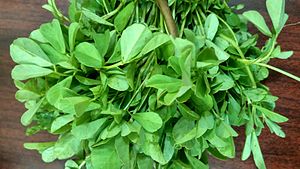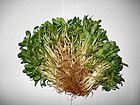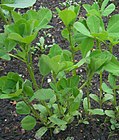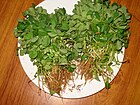Note: This is a project under development. The articles on this wiki are just being initiated and broadly incomplete. You can Help creating new pages.
Trigonella foenum-graecum - Medhika
Trigonella foenum-graecum is an annual plant in the family Fabaceae, with leaves consisting of three small obovate to oblong leaflets. It is cultivated worldwide as a semiarid crop, and its seeds are a common ingredient in dishes from the Indian subcontinent. It's leaves and seeds of medhika plant are widely used in Indian cuisine.
Contents
[hide]- 1 Uses
- 2 Parts Used
- 3 Chemical Composition
- 4 Common names
- 5 Properties
- 6 Habit
- 7 Identification
- 8 List of Ayurvedic medicine in which the herb is used
- 9 Where to get the saplings
- 10 Mode of Propagation
- 11 How to plant/cultivate
- 12 Commonly seen growing in areas
- 13 Photo Gallery
- 14 References
- 15 External Links
Uses
Diabetes, Constipation, Greasy stools, Loss of appetite, Gastric problem, Peptic Ulcers, Intestinal Gas, Flatulence, Abdominal Distension, Colon Cancer.
Parts Used
Chemical Composition
Foenum-graecum leaf is used as a green, leafy vegetable and is a good source of calcium, iron, β-carotene and several vitamins.[1]
Common names
| Language | Common name |
|---|---|
| Kannada | Mente, Mentepalle |
| Hindi | Methi |
| Malayalam | Uluva |
| Tamil | Vendayam |
| Telugu | |
| Marathi | NA |
| Gujarathi | NA |
| Punjabi | NA |
| Kashmiri | NA |
| Sanskrit | Bahuparni, Gandhaphala |
| English | Fenugreek, Greek-clover, Greek hay |
Properties
Reference: Dravya - Substance, Rasa - Taste, Guna - Qualities, Veerya - Potency, Vipaka - Post-digesion effect, Karma - Pharmacological activity, Prabhava - Therepeutics.
Dravya
Rasa
Tikta (Bitter), Kashaya (Astringent)
Guna
Laghu (Light), Ruksha (Dry), Tikshna (Sharp)
Veerya
Ushna (Hot)
Vipaka
Katu (Pungent)
Karma
Kapha, Vata
Prabhava
Habit
Identification
Leaf
| Kind | Shape | Feature |
|---|---|---|
| Simple | Alternate | The leaves are alternate, compound, trifoliolate, 7-12 cm long, light green in colour |
Flower
| Type | Size | Color and composition | Stamen | More information |
|---|---|---|---|---|
| Unisexual | 2-4cm long | Blue | 5-20 | The flowers are papillonaceous, borne in leaf axils, white, lemon-yellow or purplish blue in colour |
Fruit
| Type | Size | Mass | Appearance | Seeds | More information |
|---|---|---|---|---|---|
| Oblong | 2-10 cm | The fruits occur as straight or sickle-like pods of 2-10 cm | Green-olive or brownish in colour | 10-20 seeds | {{{6}}} |
Other features
List of Ayurvedic medicine in which the herb is used
Where to get the saplings
Mode of Propagation
How to plant/cultivate
Pre-soak the seed for 12 hours in warm water and then sow in situ. Succeeds in ordinary garden soil, preferring a well-drained loamy soil in full sun. [4]
Commonly seen growing in areas
Field verges, Uncultivated ground, Dry grasslands.
Photo Gallery
References
External Links
- Ayurvedic Herbs known to be helpful to treat Diabetes
- Ayurvedic Herbs known to be helpful to treat Constipation
- Ayurvedic Herbs known to be helpful to treat Greasy stools
- Ayurvedic Herbs known to be helpful to treat Loss of appetite
- Ayurvedic Herbs known to be helpful to treat Gastric problem
- Ayurvedic Herbs known to be helpful to treat Peptic Ulcers
- Ayurvedic Herbs known to be helpful to treat Intestinal Gas
- Ayurvedic Herbs known to be helpful to treat Flatulence
- Ayurvedic Herbs known to be helpful to treat Abdominal Distension
- Ayurvedic Herbs known to be helpful to treat Colon Cancer
- Herbs with Leaves used in medicine
- Herbs with Seeds used in medicine
- Herbs with common name in Kannada
- Herbs with common name in Hindi
- Herbs with common name in Malayalam
- Herbs with common name in Tamil
- Herbs with common name in Sanskrit
- Herbs with common name in English
- Habit - Annual plant
- Index of Plants which can be propagated by Seeds
- Index of Plants which can be propagated by Cuttings
- Herbs that are commonly seen in the region of Field verges
- Herbs that are commonly seen in the region of Uncultivated ground
- Herbs that are commonly seen in the region of Dry grasslands
- Herbs
- Fabaceae








